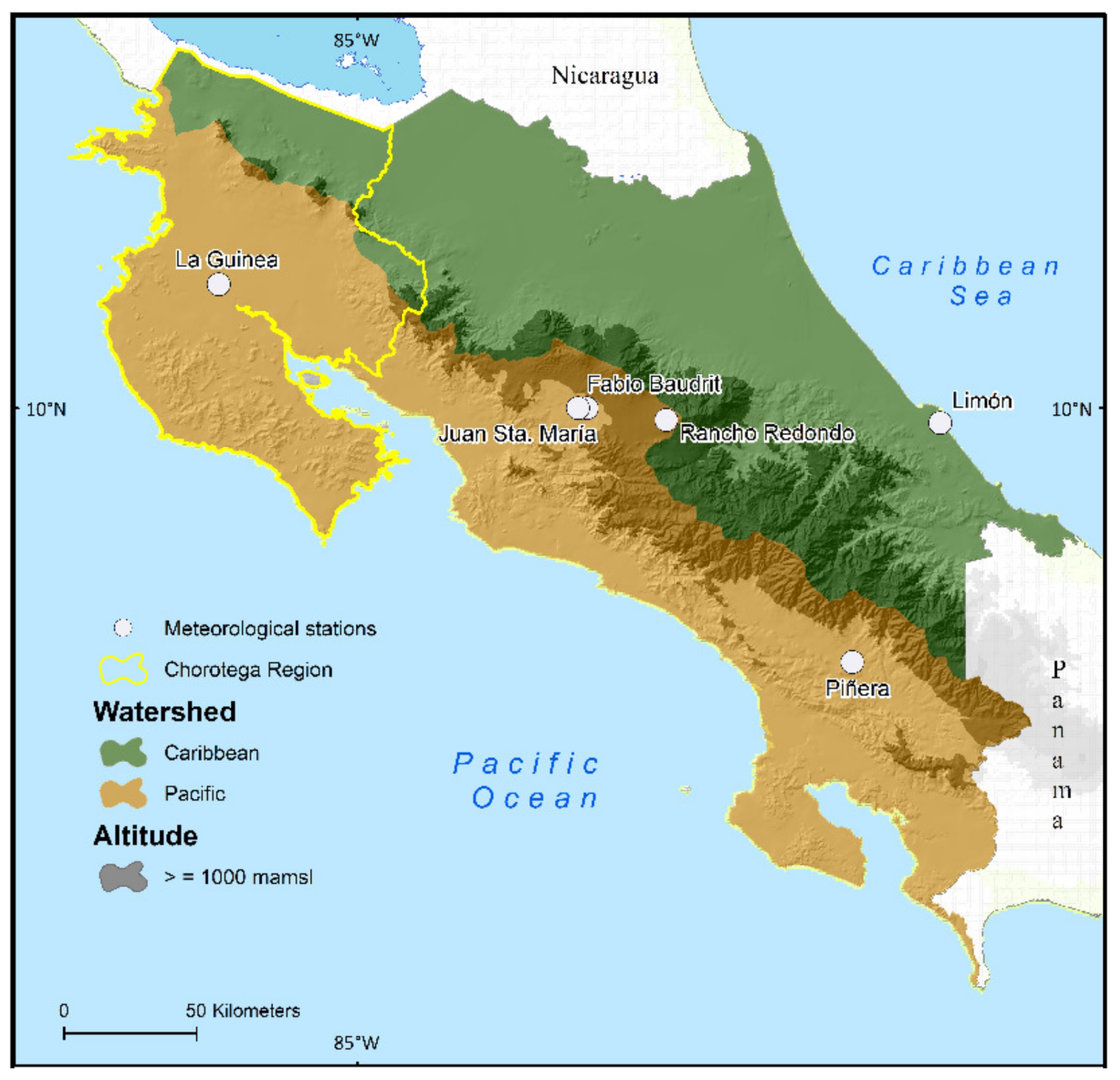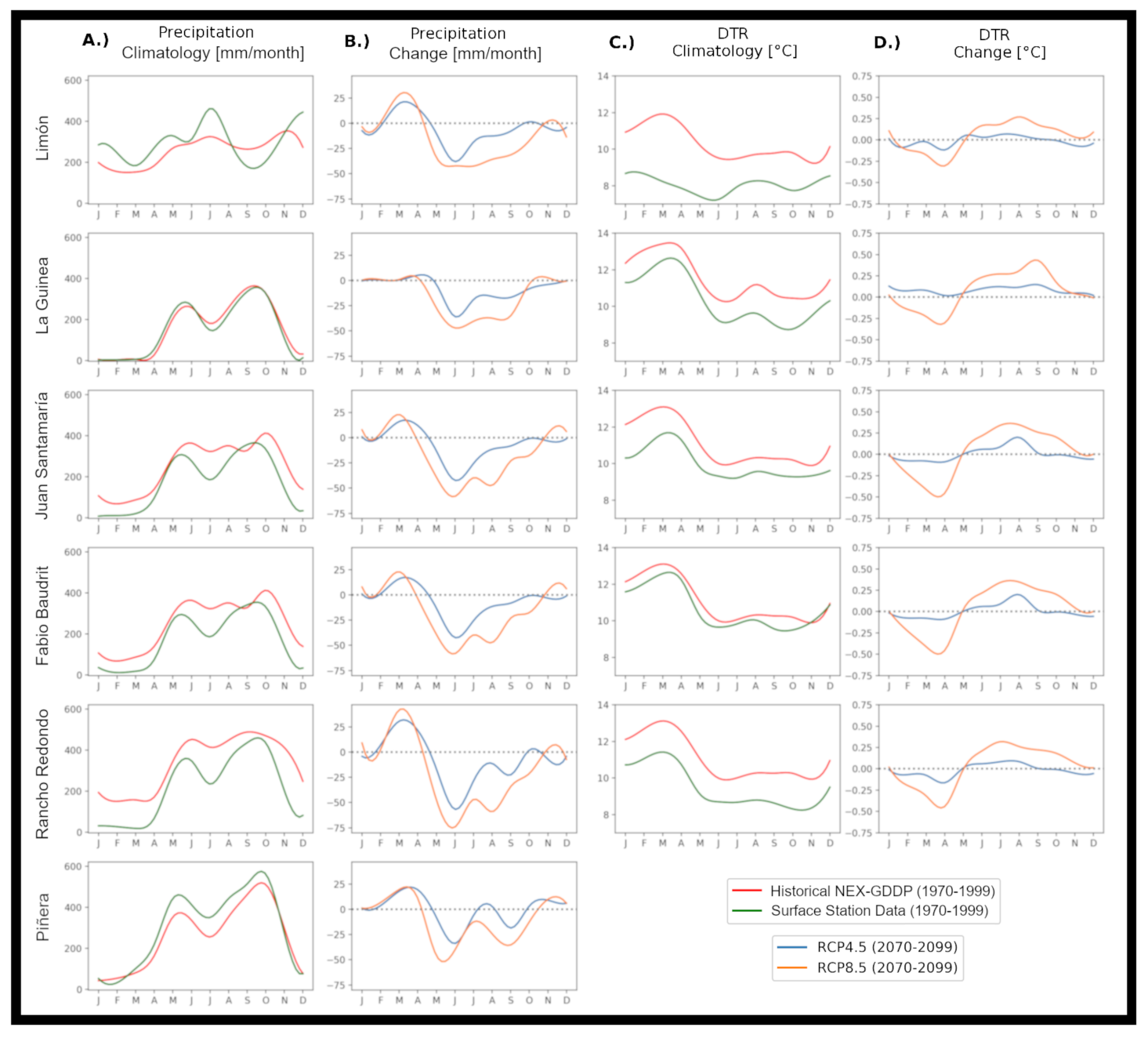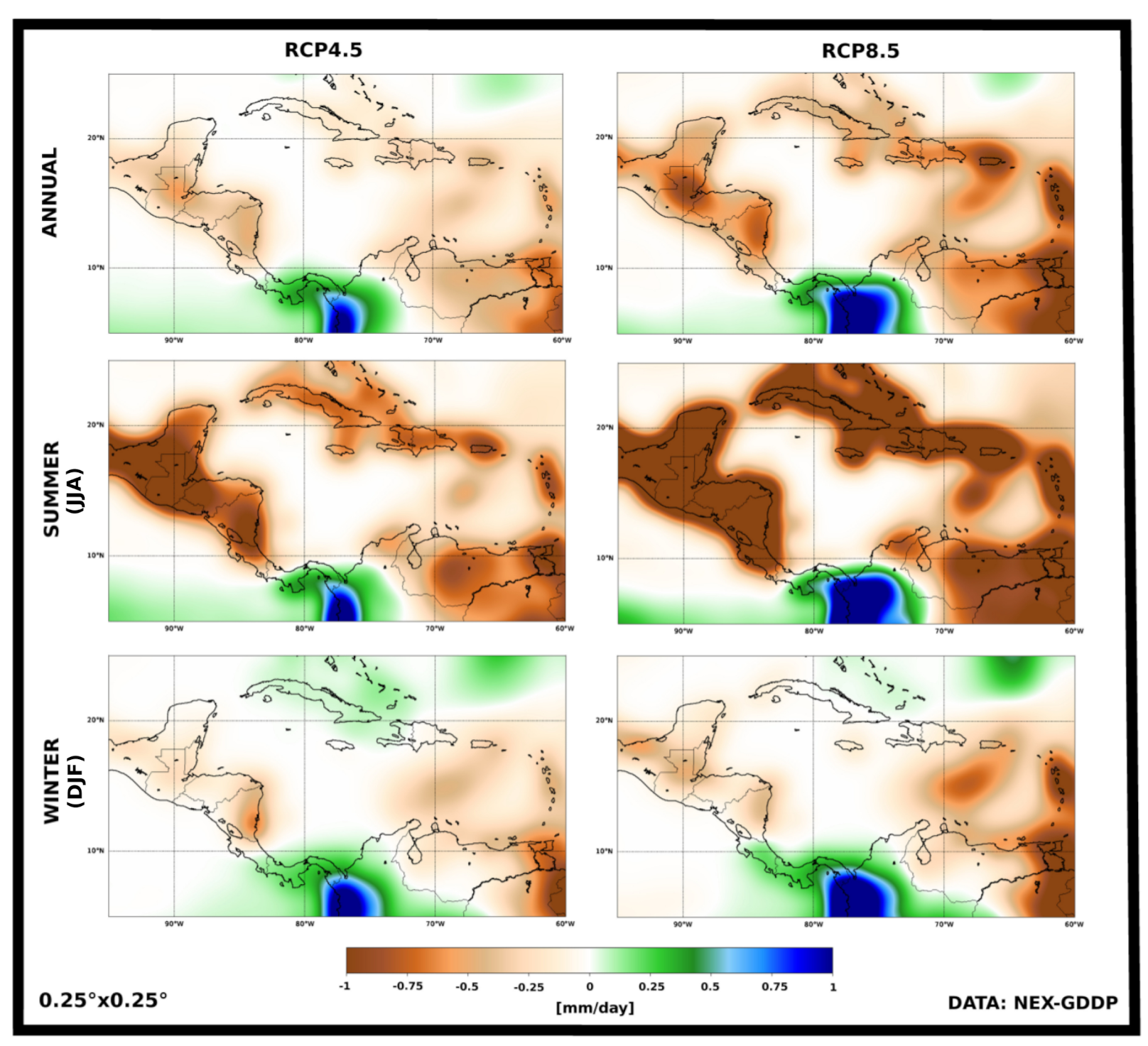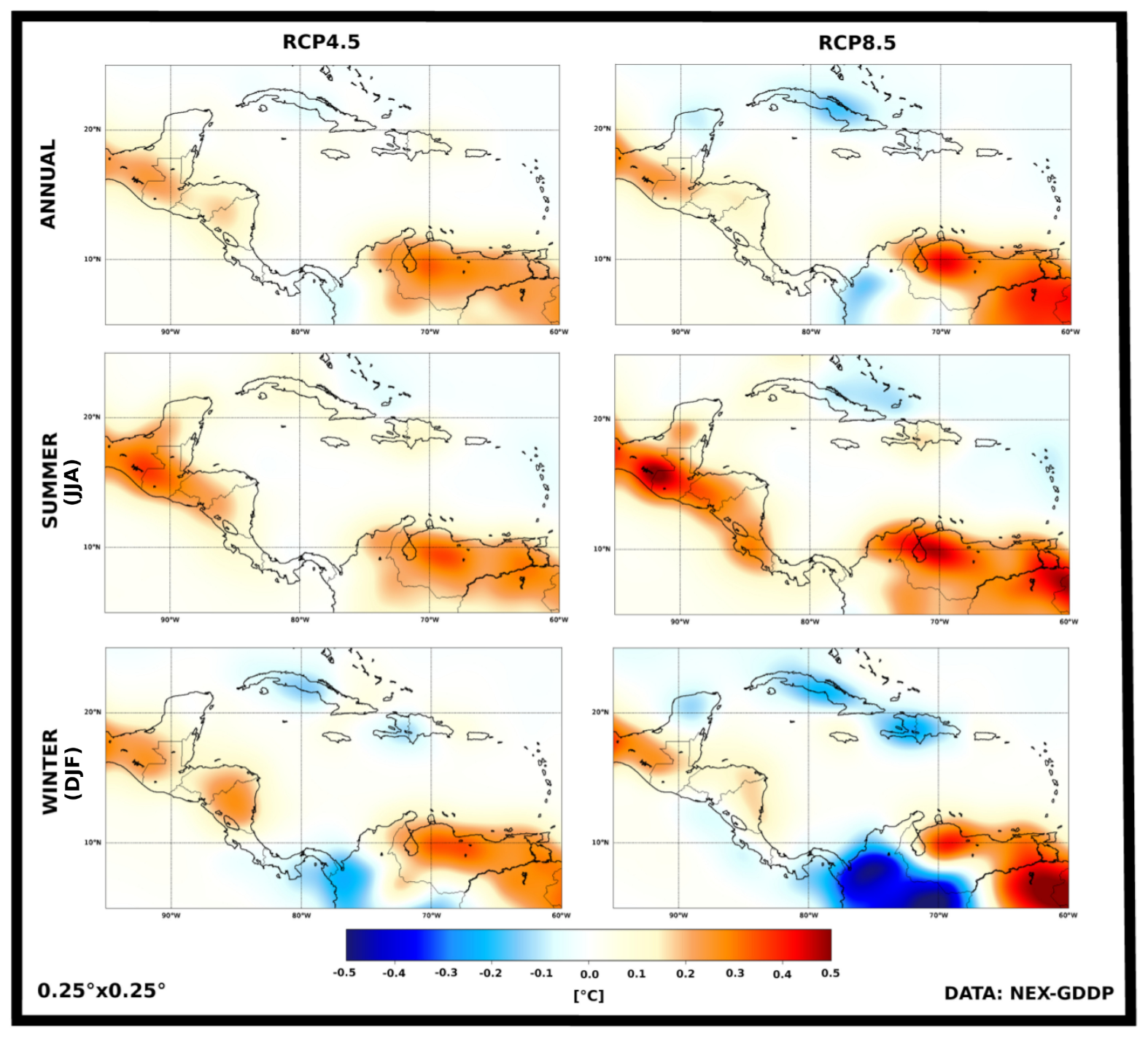Precipitation and Temperature in Costa Rica at the End of the Century Based on NEX-GDDP Projected Scenarios
Abstract
1. Introduction
2. Data and Methodology
2.1. Climate Scenarios
2.2. Surface Meteorological Stations

3. Results
3.1. Data Assessment Evaluation
3.2. Rainfall
3.3. Temperature
4. Conclusions
Author Contributions
Funding
Acknowledgments
Conflicts of Interest
Abbreviations
| NEX-GDDP | NASA Earth Exchange Global Daily Downscaled Projections |
| CMIP5 | Coupled Model Intercomparison Project version 5 |
| GCM | General Circulation Model |
| RCP | Representative Concentration Pathway |
| BCSD | Bias-Correction Spatial Disaggregation |
| DTR | Diurnal Temperature Range |
| MSD | Mid-Summer Drought |
| ITCZ | Intertropical Convergence Zone |
| NASH | North Atlantic Subtropical High |
| ENSO | El Niño Southern Oscillation |
References
- Hall, C. América central como región geográfica. In Anuario de Estudios Centroamericanos; Universidad de Costa Rica: San José, Costa Rica, 1985; pp. 5–24. [Google Scholar]
- Mittermeier, R.A.; Myers, N.; Thomsen, J.B.; Da Fonseca, G.A.; Olivieri, S. Biodiversity hotspots and major tropical wilderness areas: Approaches to setting conservation priorities. Conserv. Biol. 1998, 12, 516–520. [Google Scholar] [CrossRef]
- Pagiola, S. Payments for environmental services in costa rica. Ecol. Econ. 2008, 65, 712–724. [Google Scholar] [CrossRef]
- Pagiola, S.; Agostini, P.; Gobbi, J.; de Haan, C.; Ibrahim, M.; Murgueitio, E.; Ramírez, E.; Rosales, M.; Ruíz, J.P. Paying for biodiversity conservation services: Experience in colombia, costa rica, and nicaragua. Mt. Res. Dev. 2005, 25, 206–211. [Google Scholar] [CrossRef]
- Zbinden, S.; Lee, D.R. Paying for environmental services: An analysis of participation in costa rica’s psa program. World Dev. 2005, 33, 255–272. [Google Scholar] [CrossRef]
- Harvey, C.A.; Komar, O.; Chazdon, R.; Ferguson, B.G.; Finegan, B.; Griffith, D.M.; Martínez-Ramos, M.; Morales, H.; Nigh, R.; Soto-Pinto, L.; et al. Integrating agricultural landscapes with biodiversity conservation in the mesoamerican hotspot. Conserv. Biol. 2008, 22, 8–15. [Google Scholar] [CrossRef]
- Kosoy, N.; Martinez-Tuna, M.; Muradian, R.; Martinez-Alier, J. Payments for environmental services in watersheds: Insights from a comparative study of three cases in central america. Ecol. Econ. 2007, 61, 446–455. [Google Scholar] [CrossRef]
- Andam, K.S.; Ferraro, P.J.; Sims, K.R.; Healy, A.; Holland, M.B. Protected areas reduced poverty in costa rica and thailand. Proc. Natl. Acad. Sci. USA 2010, 107, 9996–10001. [Google Scholar] [CrossRef] [PubMed]
- Kowollik, M. Costa Rica Carbono Neutral: Un País Pequeño con Metas Grandes; PERSPECTIVAS FES Costa Rica; Fundación Friedrich Ebert: San José, Costa Rica, 2014. [Google Scholar]
- Hastenrath, S.L. Rainfall distribution and regime in central america. Arch. Meteorol. Geophys. Bioklimatol. Ser. B 1967, 15, 201–241. [Google Scholar] [CrossRef]
- Vargas, G. Las lluvias en américa central: Una climatología geográfica. In Anuario de Estudios Centroamericanos; Universidad de Costa Rica: San José, Costa Rica, 2001; pp. 7–19. [Google Scholar]
- Vargas, G. La escala zonal, regional y local en el análisis del régimen pluviométrico del istmo centroamericano. Reflexiones 2004, 83, 4. [Google Scholar]
- Alfaro, E.J.; Cid, L. Análisis de las anomalías en el inicio y el término de la estación lluviosa en centroamérica y su relación con los océanos pacífico y atlántico tropical. Tóp. Meteorol. Ocean. 1999, 6, 1–13. [Google Scholar]
- Alfaro, E.J. Response of air surface temperatures over central america to oceanic climate variability indices. Tóp. Meteorol. Ocean. 2000, 7, 63–72. [Google Scholar] [CrossRef]
- Alfaro, E.J. Some characteristics of the annual precipitation cycle in central america and their relationships with its surrounding tropical oceans. Tóp. Meteorol. Ocean. 2002, 9, 88–103. [Google Scholar]
- Alfaro, E.J.; Chourio, X.; Muñoz, Á.G.; Mason, S.J. Improved seasonal prediction skill of rainfall for the primera season in central america. Int. J. Climatol. 2018, 38, e255–e268. [Google Scholar] [CrossRef]
- Mosiño, A.P.; García, E. Evaluación de la sequía intraestival en la república mexicana. Proc. Conf. Reg. Latinoam. Unión Geogr. Int. 1966, 3, 500–516. [Google Scholar]
- Coen, E. El floklore costarricense relativo al clima. Rev. Univ. Costa Rica 1973, 35, 135–145. [Google Scholar]
- Magaña, V.; Amador, J.A.; Medina, S. The midsummer drought over mexico and central america. J. Clim. 1999, 12, 1577–1588. [Google Scholar] [CrossRef]
- Karnauskas, K.B.; Seager, R.; Giannini, A.; Busalacchi, A.J. A simple mechanism for the climatological midsummer drought along the pacific coast of central america. Atmósfera 2013, 26, 261–281. [Google Scholar] [CrossRef]
- Maldonado, T.; Rutgersson, A.; Alfaro, E.; Amador, J.; Claremar, B. Interannual variability of the midsummer drought in central america and the connection with sea surface temperatures. Adv. Geosci. 2016, 42, 35–50. [Google Scholar] [CrossRef]
- Amador, J.A. A climatic feature of the tropical americas: The trade wind easterly jet. Tóp. Meteorol. Ocean. 1998, 5, 1–13. [Google Scholar]
- Amador, J.A. The intra-americas sea low-level jet. Ann. N. Y. Acad. Sci. 2008, 1146, 153–188. [Google Scholar] [CrossRef]
- Sáenz, F.; Amador, J.A. Características del ciclo diurno de precipitación en el Caribe de Costa Rica. Rev. Climatol. 2016, 6, 21–34. [Google Scholar]
- Taylor, M.A.; Alfaro, E.J. Climate of central america and the caribbean. In Encyclopedia of World Climatology; Springer: Dordrecht, The Netherlands, 2005; pp. 183–189. [Google Scholar]
- Amador, J.A.; Alfaro, E.J.; Lizano, O.G.; Magaña, V.O. Atmospheric forcing of the eastern tropical pacific: A review. Prog. Oceanogr. 2006, 69, 101–142. [Google Scholar] [CrossRef]
- Amador, J.A.; Durán-Quesada, A.; Rivera, E.; Mora, G.; Sáenz, F.; Calderón, B.; Mora, N. The easternmost tropical pacific. part II: Seasonal and intraseasonal modes of atmospheric variability. Rev. Biol. Trop. 2016, 64 (Suppl. 1), S23–S57. [Google Scholar] [CrossRef]
- Hidalgo, H.G.; Durán-Quesada, A.M.; Amador, J.A.; Alfaro, E.J. The caribbean low-level jet, the inter-tropical convergence zone and precipitation patterns in the intra-americas sea: A proposed dynamical mechanism. Geogr. Ann. Ser. A Phys. Geogr. 2015, 97, 41–59. [Google Scholar] [CrossRef]
- Quirós, E.; Hidalgo, H.G. Variabilidad y conexiones climáticas de la zona de convergencia intertropical del pacífico este. Tóp. Meteorol. Ocean. 2016, 15, 21–36. [Google Scholar]
- Quirós, E.; Hidalgo, H.G. Interacción de la zona de convergencia intertropical del pacíico este con sistemas tropicales. Tóp. Meteorol. Ocean. 2016, 15, 33–47. [Google Scholar]
- Zárate-Hernández, E. Climatología de masas invernales de aire frío que alcanzan centroamérica y el caribe y su relación con algunos índices árticos. Tóp. Meteorol. Ocean. 2013, 12, 35–55. [Google Scholar]
- Zárate-Hernández, E. Influencia de las masas invernales de aire frío sobre el chorro de bajo nivel del caribe y sus ramas. Tóp. Meteorol. Ocean. 2014, 13, 19–40. [Google Scholar]
- Chinchilla, G.; Gutiérrez, J.; Zárate, E. Eventos extremos de lluvia ocasionados por empujes fríos que han llegado a costa rica en el periodo invernal (ndef) del año 2000 al 2010: Líneas de cortante. Tóp. Meteorol. Ocean. 2016, 15, 48–62. [Google Scholar]
- Chinchilla, G.; Gutiérrez, J.; Zárate, E. Análisis sinóptico de casos de eventos extremos de lluvia asociados a líneas de cortante de empujes fríos que han llegado a costa rica en el periodo invernal. Tóp. Meteorol. Ocean. 2017, 16, 48–62. [Google Scholar]
- Amador, J.A.; Alfaro, E.J.; Rivera, E.R.; Calderón, B. Climatic features and their relationship with tropical cyclones over the intra-americas seas. In Hurricanes and Climate Change; Springer: Dordrecht, The Netherlands, 2010; pp. 149–173. [Google Scholar]
- Mosiño, P.; García, E. Rainfall analysis in méxico and central américa. Rev. Geogr. 1972, 10, 43–64. [Google Scholar]
- Maldonado, T.; Alfaro, E.; Rutgersson, A.; Amador, J.A. The early rainy season in central america: The role of the tropical north atlantic ssts. Int. J. Climatol. 2017, 37, 3731–3742. [Google Scholar] [CrossRef]
- Amador, J.A.; Alfaro, E. La oscilación cuasi-bienal, enos y acoplamiento de algunos parámetros superficiales y estratosféricos sobre costa rica. Tóp. Meteorol. Ocean. 1996, 3, 45–54. [Google Scholar]
- Fujiwara, M.; Vömel, H.; Hasebe, F.; Shiotani, M.; Ogino, S.-Y.; Iwasaki, S.; Nishi, N.; Shibata, T.; Shimizu, K.; Nishimoto, E.; et al. Seasonal to decadal variations of water vapor in the tropical lower stratosphere observed with balloon-borne cryogenic frost point hygrometers. J. Geophys. Res. Atmos. 2010, 115, D18304. [Google Scholar] [CrossRef]
- Barlow, M.; Salstein, D. Summertime influence of the madden-julian oscillation on daily rainfall over mexico and central america. Geophys. Res. Lett. 2006, 33, L21708. [Google Scholar] [CrossRef]
- Poleo-Brito, D.; Solano León, E.; Stolz España, W. La oscilación madden-julian y las precipitationes extremas en costa rica. Tóp. Meteorol. Ocean. 2014, 13, 5–18. [Google Scholar]
- Poleo-Brito, D.; Solano León, E.; Stolz España, W. La oscilación atmosférica madden-julian (mjo) y las lluvias en costa rica. Tóp. Meteorol. Ocean. 2014, 13, 58–74. [Google Scholar]
- Durán-Quesada, A.M.; Gimeno, L.; Amador, J.; Nieto, R. Moisture sources for central america: Identification of moisture sources using a lagrangian analysis technique. J. Geophys. Res. Atmos. 2010, 115, D05103. [Google Scholar] [CrossRef]
- Durán-Quesada, A.M.; Gimeno, L.; Amador, J. Role of moisture transport for central american precipitation. Earth Syst. Dyn. 2017, 8, 147–161. [Google Scholar] [CrossRef]
- Castillo, R.; Nieto, R.; Gimeno, L.; Drumond, A. Influencia de los principales modos anulares hemisféricos y el niño-oscilación del sur (enos) en las fuentes de humedad globales de mesoamérica. Rev. Acad. Colomb. Cienc. Exactas Físicas Nat. 2019, 43, 746–763. [Google Scholar] [CrossRef]
- Krishnan, R.; Sanjay, J.; Gnanaseelan, C.; Mujumdar, M.; Kulkarni, A.; Chakraborty, S. Assessment of Climate Change over the Indian Region: A Report of the Ministry of Earth Sciences (MoES), Government of India. Springer Nat. 2020, 226. [Google Scholar] [CrossRef]
- Li, Y.; Chen, Y.; Wang, F.; He, Y.; Li, Z. Evaluation and projection of snowfall changes in High Mountain Asia based on NASA’s NEX-GDDP high-resolution daily downscaled dataset. Environ. Res. Lett. 2020, 15, 104040. [Google Scholar] [CrossRef]
- Lin, Q.; Wang, Y.; Glade, T.; Zhang, J.; Zhang, Y. Assessing the spatiotemporal impact of climate change on event rainfall characteristics influencing landslide occurrences based on multiple GCM projections in China. Clim. Chang. 2020, 162, 761–779. [Google Scholar] [CrossRef]
- Liu, B.; Lund, J.R.; Liu, L.; Liao, S.; Li, G.; Cheng, C. Climate Change Impacts on Hydropower in Yunnan, China. Water 2020, 12, 197. [Google Scholar] [CrossRef]
- Ran, H.; Li, J.; Zhou, Z.; Zhang, C.; Tang, C.; Yu, Y. Predicting the spatiotemporal characteristics of flash droughts with downscaled CMIP5 models in the Jinghe River basin of China. Environ. Sci. Pollut. Res. 2020, 27, 40370–40382. [Google Scholar] [CrossRef]
- Wang, J.; Feng, J.; Yan, Z.; Chen, Y. Future risks of unprecedented compound heat waves over three vast urban agglomerations in China. Earth’s Future 2020, 8, e2020EF001716. [Google Scholar] [CrossRef]
- Wu, Y.; Miao, C.; Duan, Q.; Shen, C.; Fan, X. Evaluation and projection of daily maximum and minimum temperatures over China using the high-resolution NEX-GDDP dataset. Clim. Dyn. 2020, 55, 2615–2629. [Google Scholar] [CrossRef]
- Abiodun, B.J.; Mogebisa, T.O.; Petja, B.; Abatan, A.A.; Roland, T.R. Potential impacts of specific global warming levels on extreme rainfall events over southern Africa in CORDEX and NEX-GDDP ensembles. Int. J. Climatol. 2020, 40, 3118–3141. [Google Scholar] [CrossRef]
- Ndhlovu, G.Z.; Woyessa, Y.E. Modelling impact of climate change on catchment water balance, Kabompo River in Zambezi River Basin. J. Hydrol. Reg. Stud. 2020, 27, 100650. [Google Scholar] [CrossRef]
- Gutierrez, A.P.; Ponti, L.; Arias, P.A. Deconstructing the eradication of new world screwworm in North America: Retrospective analysis and climate warming effects. Med. Vet. Entomol. 2019, 33, 282–295. [Google Scholar] [CrossRef]
- Iwamura, T.; Guzman-Holst, A.; Murray, K.A. Accelerating invasion potential of disease vector Aedes aegypti under climate change. Nat. Commun. 2020, 11, 1–10. [Google Scholar] [CrossRef] [PubMed]
- Avila-Diaz, A.; Abrahão, G.; Justino, F.; Torres, R.; Wilson, A. Extreme climate indices in Brazil: Evaluation of downscaled earth system models at high horizontal resolution. Clim. Dyn. 2020, 54, 5065–5088. [Google Scholar] [CrossRef]
- Vigliano, P.H.; Rechencq, M.M.; Fernández, M.V.; Lippolt, G.E.; Macchi, P.J. Fish thermal habitat current use and simulation of thermal habitat availability in lakes of the Argentine Patagonian Andes under climate change scenarios RCP 4.5 and RCP 8.5. Sci. Total Environ. 2018, 636, 688–698. [Google Scholar] [CrossRef] [PubMed]
- Giorgi, F. Climate change hot-spots. Geophys. Res. Lett. 2006, 33, L08707. [Google Scholar] [CrossRef]
- Diffenbaugh, N.S.; Giorgi, F. Climate change hotspots in the CMIP5 global climate model ensemble. Clim. Chang. 2012, 114, 813–822. [Google Scholar] [CrossRef] [PubMed]
- Taylor, K.E.; Stouffer, R.J.; Meehl, G.A. A Summary of the Cmip5 Experiment Design; PCDMI Report. 2009. Available online: https://pcmdi.llnl.gov/mips/cmip5/docs/Taylor_CMIP5_design.pdf (accessed on 26 October 2020).
- Taylor, K.E.; Stouffer, R.J.; Meehl, G.A. An overview of cmip5 and the experiment design. Bull. Am. Meteorol. Soc. 2012, 93, 485–498. [Google Scholar] [CrossRef]
- Hidalgo, H.G.; Amador, J.A.; Alfaro, E.J.; Quesada, B. Hydrological climate change projections for central america. J. Hydrol. 2013, 495, 94–112. [Google Scholar] [CrossRef]
- Hidalgo, H.; Alfaro, E.; Quesada-Montano, B. Observed (1970–1999) climate variability in central america using a high-resolution meteorological dataset with implication to climate change studies. Clim. Chang. 2017, 141, 13–28. [Google Scholar] [CrossRef]
- Maurer, E.P.; Roby, N.; Stewart-Frey, I.T.; Bacon, C.M. Projected twenty-first-century changes in the central american mid-summer drought using statistically downscaled climate projections. Reg. Environ. Chang. 2017, 17, 2421–2432. [Google Scholar] [CrossRef]
- Depsky, N.; Pons, D. Meteorological droughts are projected to worsen in Central America’s Dry Corridor throughout the 21st century. Environ. Res. Lett. 2020. [Google Scholar] [CrossRef]
- Hidalgo, H.G.; Alfaro, E.J.; Amador, J.A.; Bastidas, Á. Precursors of quasi-decadal dry-spells in the central america dry corridor. Clim. Dyn. 2019, 53, 1307–1322. [Google Scholar] [CrossRef]
- Moss, R.H.; Edmonds, J.A.; Hibbard, K.A.; Manning, M.R.; Rose, S.K.; Van Vuuren, D.P.; Carter, T.R.; Emori, S.; Kainuma, M.; Kram, T.; et al. The next generation of scenarios for climate change research and assessment. Nature 2010, 463, 747–756. [Google Scholar] [CrossRef] [PubMed]
- Van Vuuren, D.P.; Edmonds, J.; Kainuma, M.; Riahi, K.; Thomson, A.; Hibbard, K.; Hurtt, G.C.; Kram, T.; Krey, V.; Lamarque, J.-F.; et al. The representative concentration pathways: An overview. Clim. Chang. 2011, 109, 5. [Google Scholar] [CrossRef]
- Smith, S.J.; Wigley, T. Multi-gas forcing stabilization with minicam. Energy J. 2006, 373–391. [Google Scholar] [CrossRef]
- Clarke, L.; Edmonds, J.; Jacoby, H.; Pitcher, H.; Reilly, J.; Richels, R. Scenarios of Greenhouse Gas Emissions and Atmospheric Concentrations; US Department of Energy Publications: Washington, DC, USA, 2007. [Google Scholar]
- Wise, M.; Calvin, K.; Thomson, A.; Clarke, L.; Bond-Lamberty, B.; Sands, R.; Smith, S.J.; Janetos, A.; Edmonds, J. Implications of limiting co2 concentrations for land use and energy. Science 2009, 324, 1183–1186. [Google Scholar] [CrossRef]
- Thomson, A.M.; Calvin, K.V.; Smith, S.J.; Kyle, G.P.; Volke, A.; Patel, P.; Delgado-Arias, S.; Bond-Lamberty, B.; Wise, M.A.; Clarke, L.E.; et al. Rcp4. 5: A pathway for stabilization of radiative forcing by 2100. Clim. Chang. 2011, 109, 77. [Google Scholar] [CrossRef]
- Edenhofer, O.; Pichs-Madruga, R.; Sokona, Y.; Kadner, S.; Minx, J.C.; Brunner, S.; Agrawala, S.; Baiocchi, G.; Bashmakov, I.A.; Blanco, G.; et al. Technical summary. In Climate Change 2014: Mitigation of Climate Change; Cambridge University Press: Cambridge, UK, 2014. [Google Scholar]
- Riahi, K.; Grübler, A.; Nakicenovic, N. Scenarios of long-term socio-economic and environmental development under climate stabilization. Technol. Forecast. Soc. Chang. 2007, 74, 887–935. [Google Scholar] [CrossRef]
- Riahi, K.; Rao, S.; Krey, V.; Cho, C.; Chirkov, V.; Fischer, G.; Kindermann, G.; Nakicenovic, N.; Rafaj, P. Rcp 8.5—A scenario of comparatively high greenhouse gas emissions. Clim. Chang. 2011, 109, 33. [Google Scholar] [CrossRef]
- Thrasher, B.; Nemani, R. NEX-GDDP: Global Daily Downscaled Projections for Studies of Climate Change Impacts. 2015. Available online: https://esgf.nccs.nasa.gov/esgdoc/NEX-GDDP_Tech_Note_v0.pdf (accessed on 26 October 2020).
- Wood, A.W.; Maurer, E.P.; Kumar, A.; Lettenmaier, D.P. Long-range experimental hydrologic forecasting for the eastern united states. J. Geophys. Res. Atmos. 2002, 107. [Google Scholar] [CrossRef]
- Wood, A.W.; Leung, L.R.; Sridhar, V.; Lettenmaier, D. Hydrologic implications of dynamical and statistical approaches to downscaling climate model outputs. Clim. Chang. 2004, 62, 189–216. [Google Scholar] [CrossRef]
- Maurer, E.P.; Hidalgo, H.G. Utility of daily vs. monthly large-scale climate data: An intercomparison of two statistical downscaling methods. Hydrol. Earth Syst. Sci. 2008, 12, 501–563. [Google Scholar] [CrossRef]
- Thrasher, B.; Maurer, E.P.; McKellar, C.; Duffy, P. Technical note: Bias correcting climate model simulated daily temperature extremes with quantile mapping. Hydrol. Earth Syst. Sci. 2012, 16, 3309–3314. [Google Scholar] [CrossRef]
- Castillo, R.; Montero, R.; Amador, J.; Durán, A.M. Cambios futuros de precipitación y temperatura sobre américa central y el caribe utilizando proyecciones climáticas de reducción de escala estadística. Rev. Climatol. 2018, 18, 1–12. [Google Scholar]
- Wilcox, R.R. Fundamentals of Modern Statistical Methods: Substantially Improving Power and Accuracy; Springer Science & Business Media: New York, NY, USA, 2010. [Google Scholar] [CrossRef]
- Amador, J.A.; Anderson, M.J.; Calderón, B.; Pribyl, K. The October 1891 Cartago (Costa Rica) floods from documentary sources and 20CR data. Int. J. Climatol. 2018, 38, 4830–4845. [Google Scholar] [CrossRef]
- Ortiz-Malavasi, E. Atlas digital de costa rica (cr 2014). Investig. TEC 2015, 23, 1659–3383. [Google Scholar]
- Hidalgo, H.G.; Alfaro, E.J. Skill of cmip5 climate models in reproducing 20th century basic climate features in central america. Int. J. Climatol. 2015, 35, 3397–3421. [Google Scholar] [CrossRef]
- Vecchi, G.A.; Soden, B.J.; Wittenberg, A.T.; Held, I.M.; Leetmaa, A.; Harrison, M.J. Weakening of tropical Pacific atmospheric circulation due to anthropogenic forcing. Nature 2006, 441, 73–76. [Google Scholar] [CrossRef]
- Bony, S.; Bellon, G.; Klocke, D.; Sherwood, S.; Fermepin, S.; Denvil, S. Robust direct effect of carbon dioxide on tropical circulation and regional precipitation. Nat. Geosci. 2013, 6, 447–451. [Google Scholar] [CrossRef]
- He, J.; Soden, B.J. Anthropogenic weakening of the tropical circulation: The relative roles of direct CO2 forcing and sea surface temperature change. J. Clim. 2015, 28, 8728–8742. [Google Scholar] [CrossRef]
- Fuentes-Franco, R.; Coppola, E.; Giorgi, F.; Pavia, E.G.; Diro, G.T.; Graef, F. Inter-annual variability of precipitation over southern mexico and central america and its relationship to sea surface temperature from a set of future projections from cmip5 gcms and regcm4 cordex simulations. Clim. Dyn. 2015, 45, 425–440. [Google Scholar] [CrossRef]
- Parry, M.; Canziani, O.F.; Palutikof, J.P.; van der Linden, P.J.; Hanson, C.E. Climate Change 2007: Impacts, Adaptation and Vulnerability; Cambridge University Press: Cambridge, UK, 2007; Volume 4. [Google Scholar]
- Ruiz, D.; Moreno, H.A.; Gutiérrez, M.E.; Zapata, P.A. Changing climate and endangered high mountain ecosystems in Colombia. Sci. Total Environ. 2008, 398, 122–132. [Google Scholar] [CrossRef] [PubMed]
- Büntgen, U.; Martínez-Peña, F.; Aldea, J.; Rigling, A.; Fischer, E.M.; Camarero, J.J.; Hayes, M.J.; Fatton, V.; Egli, S. Declining pine growth in Central Spain coincides with increasing diurnal temperature range since the 1970s. Glob. Planet. Chang. 2013, 107, 177–185. [Google Scholar] [CrossRef]
- Skliris, N.; Zika, J.D.; Nurser, G.; Josey, S.A.; Marsh, R. Global water cycle amplifying at less than the Clausius-Clapeyron rate. Sci. Rep. 2016, 6, 1–9. [Google Scholar] [CrossRef] [PubMed]




| Model | Modeling Center |
|---|---|
| ACCESS1-0 | Commonwealth Scientific and Industrial Research Organization and Bureau of Meteorology, Australia |
| BCC-CSM1-1 | Beijing Climate Center, China Meteorological Administration, China |
| BNU-ESM | College of Global Change and Earth System Science, Beijing Normal University, China |
| CanESM2 | Canadian Centre for Climate Modeling and Analysis, Canada |
| CCSM4 | National Center for Atmospheric Research, United States |
| CESM1-BGC | Centro Euro-Mediterraneo sui Cambiamenti Climatici, Italy |
| CNRM-CM5 | National Centre for Meteorological Research, France |
| CSIRO-MK3-6-0 | Commonwealth Scientific and Industrial Research Organization and Queensland Climate Change Centre of Excellence, Australia |
| GFDL-CM3 | NOAA/Geophysical Fluid Dynamics Laboratory, United States |
| GFDL-ESM2G | |
| GFDL-ESM2M | |
| INMCM4 | Institute for Numerical Mathematics, Russia |
| IPSL-CM5A-LR | L’Institut Pierre-Simon Laplace, France |
| IPSL-CM5A-MR | |
| MIROC-ESM | Atmosphere and Ocean Research Institute (The University of Tokyo), National Institute for Environmental Studies, and Japan Agency for Marine-Earth Science and Technology, Japan |
| MIROC-ESM-CHEM | |
| MIROC5 | |
| MPI-ESM-LR | Max Planck Institute for Meteorology, Germany |
| MPI-ESM-MR | |
| MRI-CGCM3 | Meteorological Research Institute, Japan |
| NorESM1-M | Norwegian Climate Center, Norway |
| Dataset | NASA Earth Exchange Global Daily Downscaled Projections (NEX-GDDP) |
| Size | 12 TB |
| Spatial Resolution | × |
| Temporal Range | 1950–2005 historical 2006–2100 RCP 4.5 and 8.5 |
| Variables | , , |
| Reference | Thrasher and Nemani [77] |
| Station | A | Lat | Lon | O | M | O | M | O | M | O | M | O | M | O | M |
|---|---|---|---|---|---|---|---|---|---|---|---|---|---|---|---|
| Limón | 4 | 9.95 | 83.02 | 297.35 | 253.29 | 461.66 | 350.82 | 178.78 | 152.48 | 8.06 | 10.30 | 8.67 | 11.92 | 7.24 | 9.24 |
| La Guinea | 75 | 10.42 | 85.47 | 144.06 | 149.74 | 335.60 | 353.43 | 2.94 | 3.03 | 10.36 | 11.55 | 12.51 | 13.42 | 8.76 | 10.36 |
| Juan Santamaría | 868 | 10.00 | 84.22 | 168.77 | 241.39 | 355.93 | 412.27 | 7.72 | 67.70 | 9.96 | 11.10 | 11.62 | 13.10 | 9.21 | 9.89 |
| Fabio Baudrit | 845 | 10.00 | 84.25 | 165.53 | 241.30 | 340.86 | 412.27 | 11.40 | 67.70 | 10.67 | 11.10 | 12.58 | 13.10 | 9.49 | 9.89 |
| Rancho Redondo | 2028 | 9.96 | 83.95 | 209.55 | 328.68 | 435.38 | 487.50 | 18.26 | 149.99 | 9.50 | 11.10 | 11.42 | 13.12 | 8.30 | 9.93 |
| Piñera | 350 | 9.14 | 83.32 | 289.86 | 248.86 | 561.53 | 510.45 | 32.45 | 42.72 | – | – | – | – | – | – |
| Precipitation | DTR | |||
|---|---|---|---|---|
| RCP 4.5 | RCP 8.5 | RCP 4.5 | RCP 8.5 | |
| Costa Rica Continental | −16.74 | −27.51 | – | – |
| Caribbean Watershed | −21.60 | −34.02 | – | 4.6 |
| Pacific Watershed | −14.74 | −26.92 | – | – |
| Chorotega Region | −19.20 | −32.56 | 5.7 | – |
| South & Central Pacific Region | −10.20 | −19.98 | 3.4 | – |
Publisher’s Note: MDPI stays neutral with regard to jurisdictional claims in published maps and institutional affiliations. |
© 2020 by the authors. Licensee MDPI, Basel, Switzerland. This article is an open access article distributed under the terms and conditions of the Creative Commons Attribution (CC BY) license (http://creativecommons.org/licenses/by/4.0/).
Share and Cite
Castillo, R.; Amador, J.A. Precipitation and Temperature in Costa Rica at the End of the Century Based on NEX-GDDP Projected Scenarios. Atmosphere 2020, 11, 1323. https://doi.org/10.3390/atmos11121323
Castillo R, Amador JA. Precipitation and Temperature in Costa Rica at the End of the Century Based on NEX-GDDP Projected Scenarios. Atmosphere. 2020; 11(12):1323. https://doi.org/10.3390/atmos11121323
Chicago/Turabian StyleCastillo, Rodrigo, and Jorge A. Amador. 2020. "Precipitation and Temperature in Costa Rica at the End of the Century Based on NEX-GDDP Projected Scenarios" Atmosphere 11, no. 12: 1323. https://doi.org/10.3390/atmos11121323
APA StyleCastillo, R., & Amador, J. A. (2020). Precipitation and Temperature in Costa Rica at the End of the Century Based on NEX-GDDP Projected Scenarios. Atmosphere, 11(12), 1323. https://doi.org/10.3390/atmos11121323






